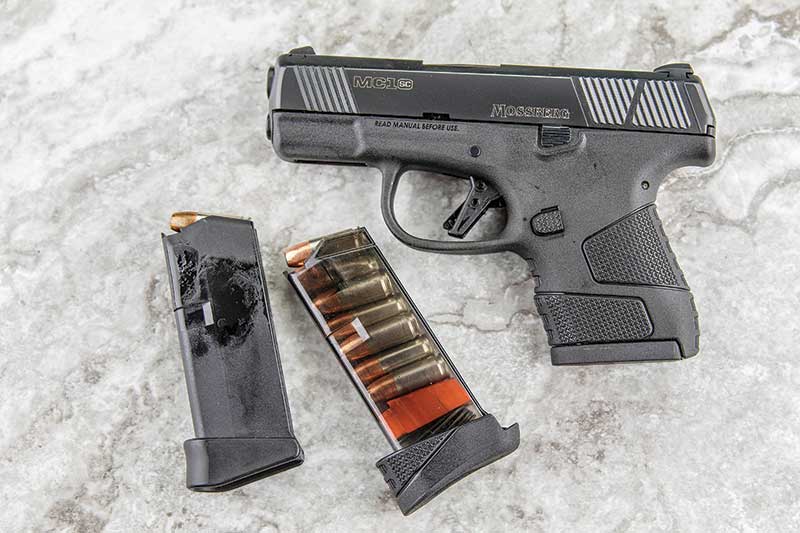General Shootability
I ran the little MC1 subcompact on the “GLOCK the Plates” course from the GLOCK Sport Shooting Foundation matches. The Mossberg pistol competes in the market directly against the G43 slim-line subcompact, which fits in the GSSF Pocket GLOCK competition.
In this event, you face a Bianchi Cup table of six 8″ diameter steel plates and are timed as you shoot them from 11 yards. Only seven rounds are allowed in the gun, so with no fudge factor to make up for more than one miss, you have to shoot it conservatively while the timer is running. Each plate left un-hit costs you a 10-second penalty. You get four runs.
With the Mossberg, using the three dots, all four of my runs went six shots/six takedowns while times ranged from 5.21- 5.84 seconds. (I told you I shot it conservatively.) Compared to the last three GSSF matches I shot this year, two runs were distinctly faster with my familiar Pocket GLOCKs while the Mossberg would have beaten my worst score even though I was new to the MC1sc. I thought this spoke well of the Mossberg’s shootability.
Continuing my rundown of the MC1sc’s shooting characteristics, I ran it through a familiar 60-shot qualification course that includes reloads (one hand only with each hand), two-handed stances, and cover positions at distances, from 4 to 15 yards. Drawn from a Galco Yaqui slide type holster, the pistol handled best with the extended magazine in place and reloads were smooth — the mags fit snugly in a single-stack leather 1911 magazine pouch, but Kydex was just a skosh too tight. The slide lock lever was easy to use as a slide release for speed reloads. Final score was 300/300 — not the best group I’ve shot on the course, but all I could ask from a subcompact pistol.
Trigger pull is critical to the shootability element. The Mossberg’s pull characteristics — while similar to the other striker-fired pistols on the market — are not quite the same. There’s a distinct two-stage pull as on a GLOCK, but still different.
Pull weight was measured on a Lyman digital trigger pull gauge. Measured from the toe of the pivoting trigger, where there is more leverage and hence less resistance, pull weight averaged 5.59 lbs. Measured from the center of the trigger, where the index finger naturally falls when shooting, it wasn’t much more — 6.84 lbs. average. Mossberg specs the MC1’s trigger pull at 5 to 6 lbs. across a 1/2″ length of pull: Meh, close enough.
One solid tactical advantage of the MC1sc is, unlike most semi-auto pistols, it will fire with the muzzle pressed against a firm object, like the ribcage of an assailant. I’m surprised this feature, known as standoff capability, is not heavily advertised.









